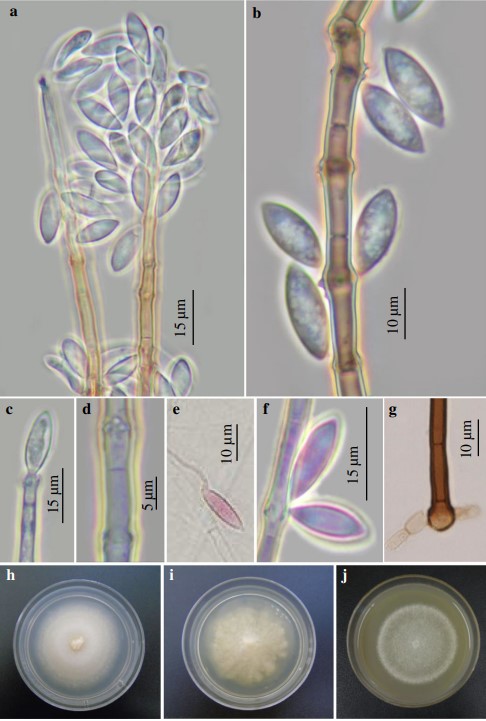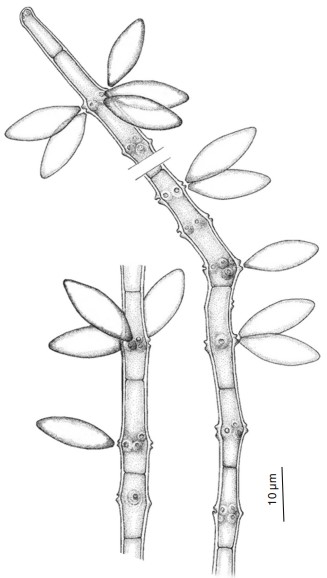Natonodosa speciosa Heredia, R.F. Castañeda & D.W. Li, in Heredia, Li, Wendt, Reblová, Arias, Gamboa-Angulo, Štěpánek, Stadler & Castañeda-Ruíz, Mycol. Progr. 19(1): 17 (2020)
Index Fungorum number: IF 819412; MycoBank number: MB 819412; Facesoffungi number: FoF 15060;
Etymology: speciosa (L.), meaning splendid, referring to its elegant appearance
Holotype – XAL-CB898 (slide)
Ex-type strains – CML-RV86; CICY031.
Saprobic on submerged decaying leaves. Asexual morph: Colonies on the natural substrate effuse, hairy, light brown or orange-brown. Mycelium superficial and immersed composed of septate, thin-walled, smooth, light brown hyphae, sometimes dark brown if near conidiophores. Conidiophores macronematous, mononematous, arise directly from the superficial mycelium, distinct in colour to vegetative hyphae, slightly inflated at the base, unbranched, upright, straight or flexuous, sometimes curved and prostrate, the conidiogenous part nodose, nodes (4)5–6(7) μm, (x̄ = 5.6 μm, n = 50) wide, up to 742 μm tall, 4–6 μm wide (x̄ = 4.8 μm, n = 25), attenuate or slightly nodose at the apex, smooth, greyish brown (5D3) to yellowish brown (5D4), subhyaline toward the apex. Conidiogenous cells polyblastic, integrated, intercalary and terminal, (13)17–49(50) × (2)3–5.5(6) μm, (x̄ = 31.6 × 4.1 μm, n = 25), nodose, greyish brown (5D3) to light brown (5D6), subhyaline toward the apex, producing conidia from up to 14 loci; conidiogenous loci denticulate, arising radially around the nodes. Conidial secession schizolytic. Conidia acropleurogenous, unicellular, broad fusiform to narrow lem- on-shaped, truncated at the base, slightly umbonate at the apex, (13)14–17(18) × 5–7(8) μm, (x̄ = 15.2 × 6.4 μm, n = 25) hyaline, sometimes guttulate, smooth-walled.
Culture characters – Colonies on MEA reaching 58-mm diam. after 15 days at 25 °C, cottony, yellowish white (3A2) at the centre, pale yellow (3A3) in the middle and toward the periphery. Margin regular. Vegetative hyphae septate, hyaline, smooth, thin-walled, 2 μm wide. Sporulation not observed. Colonies on PDA reaching 14-mm diam. after 15 days at 25 °C, weakly felt, pale yellow to white (2A2) with yellow-grey (3B2) spots, elevated and slightly sulcate in the centre, mycelium embedded. Margin undulates. Vegetative hyphae septate, hyaline, smooth, thin-walled, 2 μm wide. Sporulation not observed. Colonies on CMA reaching 42-mm diam. in 15 days at 25 °C, yellow-grey (2B2) from the centre toward the periphery, felty, mycelium embedded and superficial. Margin regular. Vegetative hyphae septate, hyaline, smooth, thin-walled, 2 μm wide. Sporulation after 32 days, conidia (14–)15–21(–22.5) × (4–)6– 8 μm, (x̄ = 16.7 × 6.7 μm, n = 25).
Material examined – MEXICO, Tabasco, Villahermosa, “La Venta” National Park, on submerged decaying leaves, 22 June 2006, G. Heredia1027. Holotype: XAL-CB898 (slide), ex-type CML-RV86 (strain).
GenBank accession numbers – CML-RV86 – ITS: MF380435; CML-RV86 – ITS: MF380435.
Notes – Based on the mode of conidiogenesis, Natonodosa can be compared with the following genera: Arthrobotrys, Cordana, Gonatobotrys, Gonatobotryum, Myrmecridium and Guarroa. The last name – Guarroa – is proposed below as nomen novum instead of Phaeobotrys (Calduch et al. 2002), assigned to an algae genus in the Chrysophyceae (Ettl 1966; Bailey et al. 1998).

Fig. 1. Natonodosa speciosa (XAL-CB898, holotype). a, b From natural substratum: Conidiophores with terminal and intercalary conidiogenous cells. c–f From corn meal agar culture (extype strain CICY030): c Apical part of conidiophore with immature conidium. d Conidiogenous cell. e Germinating conidium. f Mature conidia. g Basal region of the conidiophore. h–j Colonies on MEA, PDA and CMA.

Fig. 2 Natonodosa speciosa from natural substratum (holotype XAL- CB898): conidiophores, conidiogenous cells and conidia
